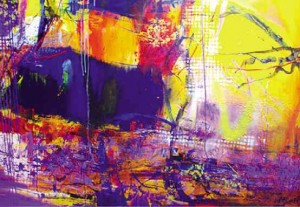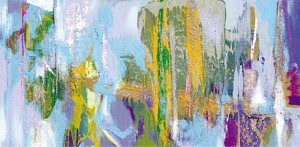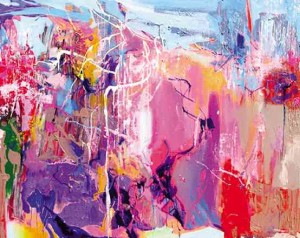
Recalibrate: to correct a measuring process by checking or adjusting again in comparison with standard.
It may at first seem curious that Edwin Wilwayco should ascribe to his most recent series of works a word that alludes to the rectification of a certain approved standard.
It is as if the artist had subjected his works to some engineering instrument that measures the quality of the present works.
But for an artist who has worked prodigiously for the past several decades, Wilwayco has arrived at a time of stocktaking, indeed, a

serious examination of an already impressively rich body of work.
From the start of his artistic career stretching back to the ’70s, Wilwayco has always worked in series. A visual concept that often refers to the French Impressionist Claude Monet, famous for his “Poplar,” “Haystack,” “Waterlily,” and the “Rouen Cathedral” series, seriality has been a driving impetus for Wilwayco.
It is how the artist has constructed and abstracted his own reality: “Jeepney Fantasia,” “Bird of Paradise,” “Climbing Vine,” “Moving Mountains,” “Whispering Wind,” “Vivaldi’s Four Season,” “Scherzo,” “Nature’s Realm”—all are visual narratives marked by an ever ascending confidence in his handling of the Abstract Expressionist idiom.

Both surprising and unexpected is Wilwayco’s fusion of form-making and chromatic enterprise. His now avowed technique of superimposition and eradication of form, burying layers and layers of pigment underneath only to emerge in insistent passages, and interlacing contrasting colors that adumbrate each other.
A simultaneous creation of form through color, these “Recalibration” paintings are exceedingly fresh and opulent, vivid and vibrant, a sheer display of the masterliness of gesture, at once, impulsive and restrained, but with every move punctiliously considered and premeditated, to elicit a thrilling painterly grace and freedom. To be sure, the impact is immediate but lingering, as though the viewer had experienced a direct assault on the retina.
There are works that defy orderliness, courting chaos, an impression made indelible by the sometimes prodigality of dripped pigment, thinned down to a lush liquidity. But in all, Wilwayco nurtures a quality of dense voluptuousness and tactile delight.
Deliverance
Simply put: The “Recalibration” works are a deliverance. They are a long sought-for, hard-won release from the bondage of a “subject”—an image, whether nature-derived or of urban
stratum—that forcibly anchored Wilwayco to a need to substantiate his form, however abstracted or stylized.
The extreme exemplar of distancing an artwork from a theme or subject is the late Chinese-French painter Zao Wou-ki, who is one of Wilwayco’s acknowledged influences, or, at least, inspirational figures.
Zao Wou-ki would not even title his works “Untitled.” Indeed, such a gesture would have been a disingenuous invitation for the audience to ascribe a subject to the work. Instead, Zao Wou-ki inscribed the date of the work’s assumed completion. It was the act of separation between artist and his work, somewhat like a finality of termination, an ultimate distancing.
Wilwayco learned crucially from an essential need to analyze his collective work—the distance that has brought him away from his trademark works. And now, to what direction will his abstraction take, at a moment in his life when he is gripped by introspection, impelled both by advancing age, as he enters the seventh decade of his life, and thereby an awareness of one’s mortality?
Was it not this same age when Wilwayco’s beloved mentor José Joya (posthumously declared National Artist) unexpectedly departed from the world?
The “Recalibration” works are a vindication. In the face of this emotional and psychic adversity, Wilwayco toughened it out, summoning a self-imposed discipline of painting at the crack of dawn, relived only by walks in the park and drives in the countryside, together with wife Loby and daughter Moma.
The relative isolation in his studio in Providence, Rhode Island, is an oasis of solitude when compared to the hectic social art scene of Metro Manila.
Fresh vitality
Wilwayco has used his solitude constructively, which resulted in his production of these new works brimming with a fresh vitality. These works are proof that abstraction has opened up
to him unexpectedly, not unlike walking into a sunlit clearing after having been lost in a dark, tangled forest.
In the “Recalibration” works, the colors sparkle, not in any cosmetic sense but in their chromatic ebullience—colors that so rejoice in their exuberance that they actually preen before the audience: lemon, chrome and canary yellows; aquamarine and cerulean blues; fuchsias, rose pinks and hot magentas; light tangerine and bright blood-orange; the emerald and jade greens, and the luscious shades of reds in gleaming splashes of scarlet, carmine and alizarin crimson.
“Drunk with color” is what will likely cross the mind of the viewer. But Wilwayco has often remarked that all his colors come from only one source: nature. Indeed, these works put the viewer in a state of welcome inebriation. Like good wine, they are full-bodied works.
The “Recalibration” works are a celebration. For Wilwayco, painting has always been linked with spirituality, an artist’s creation being merely a manifestation of the Ultimate Creator. Humility impels the artist to acknowledge that he is merely an instrument.
To be sure, it is an instrument that Wilwayco has kept finely tuned, but incontestably, it has also been an instrument that he has wrestled with, recalling the desperate struggle between Jacob and the Angel.
With the “Recalibration” works, not only has there been a truce between Wilwayco and his angelic muses, but also a celebration of a true, inspired partnership.
The overlapping brushmarks on his canvases, the restlessness of rhythm and energy, and the surging choir of colors, by turns complementary and disconcertingly dissonant yet cohesive in the end, all these are an endless resource of visual surprises and signify Wilwayco’s willingness to break open into untrammeled arenas of visual discoveries.
“Recalibration,” an exhibition of paintings by Edwin Wilwayco, is on view until July 31 in Momentous Arts Contemporary Art Gallery in Singapore. Visit www.momentousarts.com.

